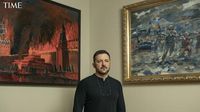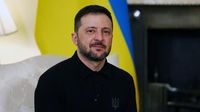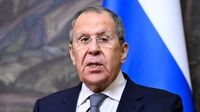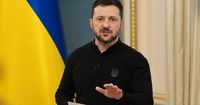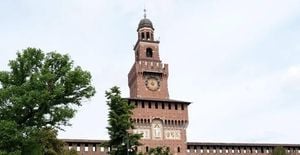Ukrainian President Wolodymyr Selenskyj has sparked outrage in Moscow after posing for a photograph in front of a painting depicting the Kremlin in flames. This provocative image is featured in the current issue of the U.S. magazine Time, where Selenskyj discusses his favorite artwork, titled "Der Traum" (The Dream), created by Georgian artist Sandro Antadze. The painting symbolizes a victory in the ongoing struggle against Russian aggression, a theme that resonates deeply with the Ukrainian leader.
The photo, taken on March 21, 2025, shows Selenskyj in his presidential office in Kyiv, standing confidently before the fiery representation of the Kremlin. Kremlin spokesperson Dmitri Peskov did not hold back in his criticism, stating, "This probably best shows the level of mental development and the inner state of someone who poses for such photos." Commentators in Russia have described Selenskyj's pose as "sick," reflecting the heightened tensions between the two nations.
Selenskyj's choice of decor in his office is telling. Alongside the painting of the burning Kremlin, he has a picture above his bed of a sinking Russian warship in the Black Sea—an image that commemorates the Ukrainian victory in 2022 when they successfully sank the vessel. Another painting in his office depicts Ukrainian troops engaged in combat on Russian territory, particularly in the Kursk region, further emphasizing the ongoing conflict.
In his interview with Time, Selenskyj elaborated on the significance of these images. He stated, "Every picture is about victory," underscoring the resilience and determination of the Ukrainian people in the face of adversity. This sentiment is not just about military success; it encapsulates the dignity and sovereignty of Ukraine as a nation.
Selenskyj also reflected on a past incident at the White House involving former U.S. President Donald Trump and Senator JD Vance, where he felt his country's dignity was at stake. He expressed disappointment during that visit, hoping for a demonstration of U.S. support, stating, "At that moment, I felt like I was not an ally or did not occupy the position of an ally." He emphasized that his defense of Ukraine's dignity was paramount during that challenging exchange.
Commenting on the broader implications of the war, Selenskyj suggested that Russia has used disinformation to influence certain individuals within the U.S. administration. He noted, "I believe Russia has managed to influence some people in the White House through information. Their signal to Americans was that Ukrainians do not want to end the war and that something should be done to force them." This highlights the complexities of international relations and the challenges Ukraine faces in securing support from its allies.
The painting "Der Traum" has a rich backstory. Created in 2022, it was also featured in Selenskyj's New Year's address on December 31, 2023, where he remarked, "The one who brings hell to our country will one day see it from his own window." This statement not only reflects his resolve but also serves as a rallying cry for the Ukrainian people, reinforcing their collective spirit against Russian aggression.
As the war continues, the symbolism behind Selenskyj's selected artworks resonates deeply with the ongoing struggle for Ukrainian sovereignty. The Kremlin's harsh reaction to his recent photo serves as a reminder of the sensitive nature of imagery and messaging in the context of war. With each public appearance, Selenskyj aims to convey strength and unity, using art as a vehicle for his message.
In addition to the paintings that adorn his office, Selenskyj's personal reflections on the war illustrate the heavy burden he carries as a leader during these tumultuous times. His commitment to defending Ukraine's dignity and sovereignty remains steadfast, even in the face of international scrutiny and criticism.
The outrage from Moscow over Selenskyj's pose is indicative of the broader tensions that exist between Ukraine and Russia. As the conflict drags on, the stakes continue to rise, and the importance of symbolism and public perception cannot be understated. The Ukrainian president's strategic use of art to communicate resilience and hope in the face of adversity is a powerful reminder of the role that culture plays in shaping national identity.
As the situation evolves, the international community watches closely. Selenskyj's actions and statements continue to shape the narrative surrounding the conflict, influencing public opinion and diplomatic relations. The image of the burning Kremlin may serve as a potent symbol of Ukraine's fight for freedom, but it also highlights the deep divisions that persist in the region.
In conclusion, Selenskyj's provocative pose before the painting of the Kremlin in flames encapsulates the ongoing struggle between Ukraine and Russia. As both nations navigate the complexities of war and diplomacy, the role of art and symbolism in shaping national identity and public perception remains crucial. The world will continue to observe how these dynamics unfold in the coming months.
